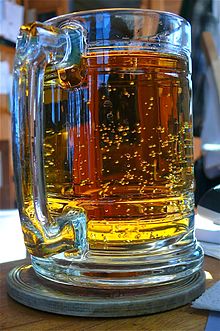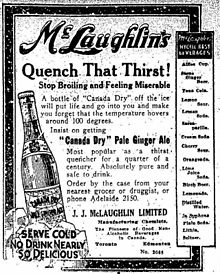Ginger ale
 Vernors golden ginger ale | |
| Type | Non-alcoholic mixed drink |
|---|---|
| Country of origin | Ireland and Canada |
| Region of origin | Northern Ireland and Southern Ontario, Canada |
| Introduced | 1851 (Golden) and 1904 (Dry) |
| Proof (US) | 0 |
| Colour | Golden |
| Flavour | Ginger |
| Variants | Golden ginger ale and dry ginger ale |
Ginger ale is a carbonated soft drink flavoured with ginger. It is consumed on its own or used as a mixer, often with spirit-based drinks. There are two main types of ginger ale. The golden style is credited to the Irish doctor Thomas Joseph Cantrell. The dry style (also called the pale style), a paler drink with a much milder ginger flavour, was created by Canadian John McLaughlin.
History
[edit]Thomas Joseph Cantrell, an Irish apothecary and surgeon, manufactured the first ginger ale in Belfast, Ireland, in the 1850s. This was the older golden style fermented ginger ale, dark coloured, generally sweet to taste, with a strong ginger spice flavour, [clarification needed] which he marketed through local beverage manufacturer Grattan and Company.[1] Grattan embossed the slogan "The Original Makers of Ginger Ale" on its bottles.[2] Ginger ale is transparent, whereas ginger beer, a stronger tasting product, is often cloudy due to the residues of brewing.

Dry ginger ale was created by Canadian John J. McLaughlin, a chemist and pharmacist.[3] Having established a soda water bottling plant in 1890, McLaughlin began developing flavour extracts to add to the water in 1904. That year, he introduced "Pale Dry Ginger Ale", the bubbly drink that would be patented in 1907 as "Canada Dry Ginger Ale". A success, Canada Dry products were accepted by appointment to the Vice-Regal Household of the Governor General of Canada. The dry-style also became popular in the United States during the Prohibition era, when it was used as a mixer for alcoholic beverages.[4]
Ingredients
[edit]Traditional ginger ale is fermented from a microbial starter culture (yeast or ginger bug), sugar, fresh ginger root, other flavourings and water. Ginger bug can be derived from ginger beer plant containing Saccharomyces florentinus and Lactobacillus hilgardii or fresh ginger root containing Lactobacillus bacteria and wild yeast. The carbonation comes from the yeast fermentation as opposed to carbonating the finished product. Ethanol, as a byproduct of fermentation, will be present in the ginger ale but can be controlled by modifying fermentation time.
Artificial Flavors in Ginger Ale
However, many commercial ginger ales contain artificial flavors in ginger ale to enhance the taste, especially if the product doesn’t use a significant amount of real ginger. These artificial flavors are often derived from chemicals designed to mimic the taste of ginger, citrus, or other spices. While these flavors make the drink more consistent in taste and less expensive to produce, they can be a concern for people sensitive to synthetic additives. Consumers seeking a more natural option should always check labels for any signs of artificial ingredients.[5]
Commercial ginger ale commonly contains carbonated water, sugar or high-fructose corn syrup, and artificial or natural ginger-flavour. Ginger content is often listed on labels in a general "natural aroma" or "natural flavouring" statement, to preserve secrecy of the complex proprietary mix of spices, fruits and other flavours used;[citation needed] lemon, lime, and cane sugar are the most common ingredients.[citation needed] Pineapple and honey are also occasionally used.[citation needed]
Processing
[edit]Fermentation
[edit]
Traditional ginger ale is fermented using ginger, yeast, water, sugar, and possibly other flavourings. A ginger bug – a slurry of ginger and sugar used to propagate the yeast and bacteria found on the ginger skin – may be used in place of commercial yeast.[6] Sugar is not added simply for sweetness; ginger's low natural sugar content (1.7g sugar/100g) does not contain enough to complete fermentation.[7] As with other fermented beverages, sugar is fermented by the yeast into ethanol and carbon dioxide,[8] both retained during brewing in an airtight container.
Artificial carbonation
[edit]Rather than ferment their product, most commercial ginger ale bottlers will carbonate their soda by chilling the water to a low temperature to allow more carbon dioxide to be dissolved.[9] Then, alkaline compounds such as sodium bicarbonate may be added to reduce acidity. Lastly, carbon dioxide is added and slightly over-pressurized to facilitate movement into storage and the filling machine.[9]
Uses
[edit]
As a drink
[edit]Ginger ale is popular both as a soft drink and a mixer in cocktails and punch. It is sometimes used by non-drinkers or in the performing arts as a non-alcoholic substitute for champagne or beer, since the beverages resemble each other in appearance. Ginger ale is also added to beer to make shandy.[10]
As a stomach pain palliative
[edit]Ginger ale, as with other ginger products and other non-ginger-flavoured carbonated beverages, have been used as a home remedy for indigestion[11] or motion sickness.[12] Some people believe that flat ginger ale is preferred.[13]
Nutrition
[edit]Ginger ale is usually acceptable for people on a clear liquid diet.[14] It is generally high in sugar, with commercial varieties containing around 10 g of sugar per 100 ml.[citation needed]
Variations
[edit]Ginger ale vs ginger beer
[edit]Ginger ale and ginger beer are similar beverages, however, there are clear differences during the process. Ginger beer originated in England in the 1800s while ginger ale was founded in Ireland approximately 50 years later before it was modernized in 1907 by John McLaughlin.[15] Original ginger beer contains 11% alcohol, but modern ginger beer contains less than 0.5% alcohol while modern ginger ale has absolutely no alcohol content.[16] Ginger beer is brewed with natural ginger, lemon juice, sugar and it is fermented with a ginger beer plant culture (mainly Lactobacillus). The fermentation of the Lactobacillus produces a cloudy appearance, stronger-tasting and spicier flavour compared to ginger ale. Other differences between ginger ale and ginger beer are in terms of taste and aroma. Whilst ginger ale is mellow and smells sweet, ginger beer has a spicy whiff and gingery taste.[17]
| Factor | Ginger Ale | Ginger Beer |
|---|---|---|
| Ingredients | Carbonated water, sweeteners, flavorings, ginger extract | Brewed ginger, sugar, water, yeast (fermented) |
| Caffeine Content | Usually caffeine-free | Can have trace amounts of caffeine depending on the brand |
| Taste Profile | Mild, sweet, and subtle ginger flavor | Strong, spicy, and more intense ginger taste |
| Alcohol Content | Non-alcoholic | Typically non-alcoholic but can have trace amounts due to fermentation |
| Health Benefits | Soothes an upset stomach, nausea, and aids hydration | Often used for its digestive benefits, but can be too spicy for some |
| Ideal for | People avoiding caffeine, those with a sensitive stomach | Those who enjoy stronger flavors and a more robust ginger taste |
| Best Use | A calming drink for nausea or mild digestive issues | A refreshing, flavorful drink for those looking for something more intense[18] |
Other flavours
[edit]Dry ginger ale is also sold with a mint flavouring added.[where?] Some mint ginger ale brands have an artificial green colour added, while others are clear. Canada Dry has introduced a line of ginger ale mixed with green tea and one mixed with lemonade.[when?]
Manufacturers
[edit]
Vernors, Blenheim, A-Treat, Bull's Head, Chelmsford, Buffalo Rock, Sussex and Red Rock are brands of golden ginger ale. Canada Dry, and Seagram's, both Canadian companies, and Schweppes, are major brands of dry ginger ale.
North America
[edit]American brands include Canfield's, Hansen Natural, Vernors, Buffalo Rock, Boylan Bottling Company, Polar Beverages, Ale-8-One, Blenheim, Foxon Park, Fitz's, Sprecher, Market Basket/Chelmsford, Red Rock, Reed's Ginger Brew, Chek (River of Dreams), Shasta, and in Canada; Sussex Golden Ginger Ale.
Vernors is a flavoured golden ginger ale aged for three years in oak barrels before bottling. It was the first U.S. soft drink, originating in 1866, although it was modelled on imported Irish ginger beers. In Detroit, Michigan, a drink made with vanilla ice cream and Vernors ginger ale is called a Boston cooler.
South America
[edit]- Cunnington
Asia
[edit]- Evervess
- East Imperial
- Kohodo
See also
[edit]- Ginger tea
- Ginger wine
- List of brand name soft drinks products
- List of soft drink flavors
- List of soft drink producers
- List of soft drinks by country
- Switchel
References
[edit]- ^ "THE SPARKLING HISTORY OF CANTRELL & COCHRANE". Let's Look Again. November 2016. Retrieved October 19, 2018.
- ^ "Federation of Historical Bottle Collectors" (PDF). FOHBC. Retrieved October 3, 2013.
- ^ "Canadian food firsts". Canadian Geographic. January–February 2002. Archived from the original on June 24, 2013. Retrieved October 31, 2012.
- ^ Tallon, Beverley. "Canada Dry Ginger Ale". The Beaver. 88 (6): 10.
- ^ Ratndip (November 28, 2024). "Does Ginger Ale Have Caffeine The Truth". Retrieved November 28, 2024.
- ^ Graham, Colleen. "Make a Ginger Bug for Healthy Homemade Sodas". The Spruce Eats. Dotdash. Retrieved July 29, 2020.
- ^ "Food Composition Databases Show Foods -- Ginger root, raw". ndb.nal.usda.gov. Archived from the original on April 3, 2019. Retrieved August 9, 2018.
- ^ "How to Make Alcoholic Ginger Ale". Homebrewing Learn Center. June 13, 2016. Archived from the original on August 9, 2018. Retrieved August 9, 2018.
- ^ a b "How soft drink is made - production process, making, history, used, product, industry, machine". www.madehow.com. Retrieved August 9, 2018.
- ^ "Drinks containing Ginger Ale. Choose from 234 drink recipes containing Ginger Ale". Bar None Drinks. Retrieved January 5, 2013.
- ^ Geographic, National (2014). National Geographic Complete Guide to Natural Home Remedies: 1,025 Easy Ways to Live Longer, Feel Better, and Enrich Your Life. National Geographic Books. p. 28. ISBN 9781426212604.
- ^ Naranjo, Ralph (September 12, 2014). The Art of Seamanship: Evolving Skills, Exploring Oceans, and Handling Wind, Waves, and Weather. McGraw Hill Professional. pp. 66–67. ISBN 9780071791588.
- ^ Gnirrs, Gary (March 2019). "Canada Dry by Design". Food in Canada. 79 (2): 14.
- ^ Williams, Patricia A. (December 23, 2016). deWit's Fundamental Concepts and Skills for Nursing - E-Book. Elsevier Health Sciences. p. 487. ISBN 9780323483285.
- ^ Daily, Kitchen (April 20, 2012). "The Difference Between Ginger Ale And Ginger Beer". Huffington Post. Retrieved August 9, 2018.
- ^ "What's the Difference Between Ginger Beer and Ginger Ale?". Town & Country. February 13, 2018. Retrieved August 9, 2018.
- ^ "Ginger Beer vs Ginger Ale: Which One Should You Use?". Advanced Mixology. Retrieved August 18, 2019.
- ^ bachute, ratndip (28-11-2024). "Does Ginger Ale Have Caffeine The Truth". sip smartly.
{{cite web}}: Check date values in:|date=(help)CS1 maint: url-status (link)
